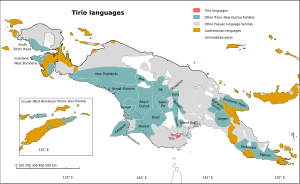

| Tirio | |
|---|---|
| Lower Fly River | |
| Geographic distribution | New Guinea |
| Linguistic classification | Trans–New Guinea |
| Glottolog | tiri1259 |

Map: The Tirio languages of New Guinea
The Tirio languages
Other Trans–New Guinea languages
Other Papuan languages
Austronesian languages
Uninhabited
| |
The Tirio languages are a familyofTrans–New Guinea languages in the classification of Malcolm Ross. The Tirio languages have about 40% of their lexicon in common.
Evans (2018) lists the Tirio languages as:[2]
Baramu is somewhat more divergent in vocabulary, but this may reflect language contact rather than divergence in its position within the family. Pronouns are only available for Tirio itself (Makayam).
The moribund language Abom was once classified as a divergent Tirio language, sharing only an eighth of its lexicon with the others, but it turns out to not belong to the family at all, nor to the Anim family that Tirio is a branch of.[3]
A survey of the Tirio languages can be found in Jore and Alemán (2002).[4]
Usher (2020) reconstructs the consonant inventory as follows:[5]
| *m | *n | ||
| *p | *t | *k | |
| *mb | *nd | *ŋg | |
| *s | |||
| *w | *ɾ | *j | *ɣ |
Vowels are *a *e *i *o *u.
The pronouns are:[5]
| sg | pl | |
|---|---|---|
| 1 | *naoɣ | *naoj |
| 2 | *ɣaoɣ | *jaoɣ |
| 3m | *igi | *jiɣ |
| 3f | – |
Lower Fly River (Makayam and Baramu) reflexes of proto-Trans-New Guinea (pTNG) etyma:[6]
|
| |
|---|---|
| Tirio (Lower Fly) |
|
| Boazi (Lake Murray) |
|
| Marind–Yaqai |
|
| Inland Gulf |
|
|
| |||||||||||||||||||||||||||||||||
|---|---|---|---|---|---|---|---|---|---|---|---|---|---|---|---|---|---|---|---|---|---|---|---|---|---|---|---|---|---|---|---|---|---|
| Official languages |
| ||||||||||||||||||||||||||||||||
| Major Indigenous languages |
| ||||||||||||||||||||||||||||||||
| Other Papuan languages |
| ||||||||||||||||||||||||||||||||
| Sign languages |
| ||||||||||||||||||||||||||||||||